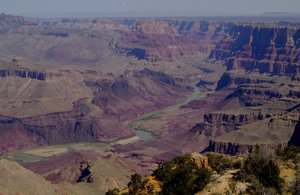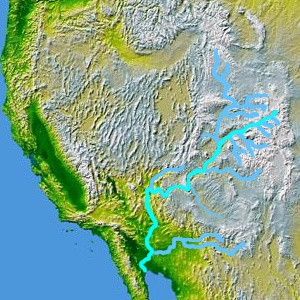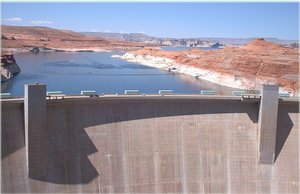Colorado River
|
|
- For other uses, see Colorado River (disambiguation).
The Colorado River is a river in the southwestern United States and northwestern Mexico, approximately 1,450 mi (2,333 km) long, draining a part of the arid regions on the western slope of the Rocky Mountains. The natural course of the river flows into the Gulf of California, but the heavy use of the river as a fresh water source has desiccated the lower course of the river in Mexico such that it no longer reaches the sea.
There are other rivers with the name Colorado River, but this one is the longest.
Spanish explorer Melchior Diaz was one of the first Europeans to explore the river in 1540.
| Contents |
Course
Its headwaters are in Colorado inside Rocky Mountain National Park (see also: Grand Lake). The Green River cuts its way through the Uinta Mountains of Utah; then flowing intermittently in the open, it crosses successive uplifts in a series of deep gorges, then through Flaming Gorge Reservoir and on to its junction with the Colorado River.
The Colorado in its course below the junction has formed a region that is one of the most wonderful of the world, not only for its unique and magnificent scenery, but also because it affords the most remarkable example known of the work of differential weathering and erosion by wind and water and the exposure of geologic strata on an enormous scale. Above the Paria the river flows through comparatively tame scenery until it reaches the plateau of the Marble Canyon, some 60 miles in length. The walls here are at first only a few score of feet in height, but increase rapidly to almost 5000 feet.
At its southern end is the Little Colorado. Above this point eleven rivers with steep mountain gradients have joined either the Green or the Grand or their united system. The Little Colorado has cut a trench 1800 feet deep into the plateau in the last 27 miles as it approaches the Colorado, and empties into it 2625 feet above sea level.
Here the Colorado turns abruptly west directly athwart the folds and fault line of the plateau, through the Grand Canyon, which is 217 miles long and from 4 to 20 miles wide between the upper cliffs. The walls, 4000 to 6000 feet high, drop in successive escarpments of 500 to 1600 feet, banded in splendid colours, toward the gloomy narrow gorge of the present river.
Below the confluence of the Virgin River of Nevada the Colorado abruptly turns southward, and forms part of the boundary between Arizona and Nevada, and the border between Arizona and California.
Below the Black Canyon the river lessens in gradient, and in its lower course flows in a broad sedimentary valley's distinct estuarine plain upriver from Yuma, where it joined by the Gila River. The channel through much of this region is bedded in a dyke-like embankment lying above the floodplain over which the escaping water spills in time of flood. This dyke cuts off the flow of the river to the remarkable low area in southern California known as the Salton Sink, or Coahuila Valley, the descent to which from the river near Yuma is very much greater than the fall in the actual river-bed from Yuma to the gulf.
The lower course of the river, which forms the border between Baja California and Sonora, is essentially a dry stream today due to use of the river as a water source. Prior to the mid 20th century, the Colorado Delta provided a rich estuarine marshland that is now essentially desiccated.
Engineering
In the autumn of 1904, the diversion flow from the river into a canal heading in Mexican territory a few miles below Yuma, and intended for irrigation of California south of the Sink, escaped control, and the river, taking the canal as a new channel, recreated in California a great inland sea to the bed of which it had frequently been turned formerly, for example, in 1884 and 1891, and for a time practically abandoned its former course through Mexican territory to the Sea of Cortez. But it was effectively dammed in the early part of 1907 and returned to its normal course, from which, however, there was still much leakage to the Salton Sea; in July 1907 the permanent dam was completed. From the Black Canyon towards the sea the Colorado normally flows through a desert-like basin.
The Colorado is a major and in some cases life-sustaining source of water for irrigation, drinking, and other uses by people living in the arid American southwest. Allocation of the river's water is governed by the Colorado River Compact. Several dams are built along the Colorado River beginning with Glen Canyon Dam near the Utah-Arizona border; other dams include Hoover Dam, Parker Dam and Davis Dam. Since the completion of the dams, every drop of water is removed from the river or evaporates before it reaches the sea. The river has not flowed to the Gulf of California for decades.
Hoover Dam (originally Boulder Dam), the first dam of its type was completed on the Colorado River in 1936 and impounds the waters of the river in the Mojave Desert, creating Lake Mead. The water is used for irrigation and to produce hydroelectric power.
Several cities such as Los Angeles, San Diego, Phoenix and Tucson have aqueducts leading all the way back to the Colorado River. One such aqueduct is the Central Arizona Project ("CAP") canal which was begun in the 1970s and finished in the 1990s. The canal begins at Parker Dam and runs all the way to Phoenix and then Tucson to supplement those cities' water needs.
See also
External links
- Drought Watch Campaign (http://www.livingrivers.org/campaigns/drought/map.cfm) - map of the Colorado River system showing the fill levels of major reservoirs
- Dams on the Lower Colorado River (http://www.citlink.net/~davegun/index.html) - A look at all the Dams on the Colorado River from Las Vegas Nevada to Mexicode:Colorado (Fluss)



